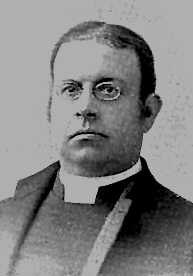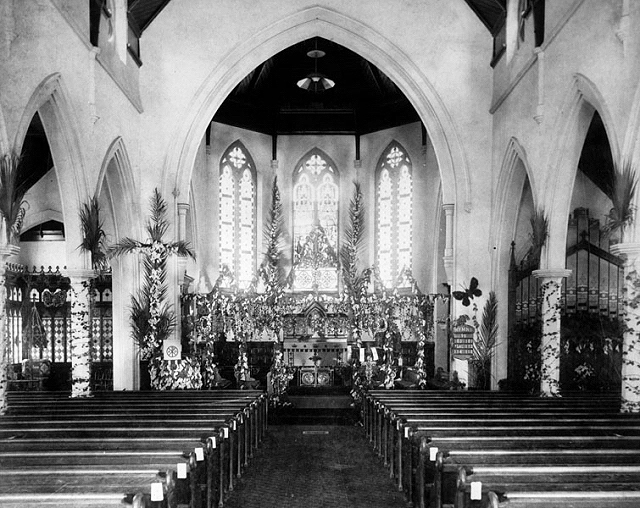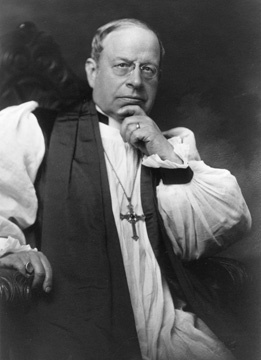
Old St. Paul’s Cathedral, located at the present site of the Biltmore Hotel in Los Angeles (Olive Street). Photo: Archives of the Diocese of Los Angeles
[The Episcopal News] When – 125 years ago today – Bishop Joseph Horsfall Johnson addressed the first convention meeting of his new Southern California diocese named for the angels, he invoked the heavenly hosts’ familiar greeting, “Fear not!”
Seeking to inspire courage among pioneering delegates, Johnson suggested for the fledgling Diocese of Los Angeles a “watchword… which I trust we may often have in our thoughts during this and every convention that may meet hereafter.”
It was May 26, 1896 – the Tuesday after Whitsunday had commemorated the Pentecost beginnings of the early church – when Johnson opened the convention’s three-day meeting in the nave of St. Paul’s Church, 523 S. Olive Street, Los Angeles, then a city of some 75,000 residents.
Built in 1883 in the Carpenter Gothic style, the wooden church faced Central Park, later named Pershing Square to honor the famous World War I general. In 1899, Johnson designated St. Paul’s the diocese’s first pro-cathedral. Its site was sold to make way for the Biltmore Hotel, and a new cathedral was completed in 1924 on Figueroa Street. The congregation later continued in Echo Park and is the namesake of today’s St. Paul’s Commons.

Bishop-elect Joseph H. Johnson is pictured in 1895. Photo: Archives of the Diocese of Los Angeles
“These words spake the angels to the shepherds whose hearts were filled with mighty dread,” Johnson reminded the 34 clergy and 93 lay delegates gathered from across eight Southern California counties, a region which the Episcopal Church’s General Convention voted on Oct. 8, 1895 in Minneapolis to divide from the San Francisco-based Diocese of California.
The “same words comforted those who came to the empty tomb where the Savior had been laid,” Johnson told the delegates, many of whom had earlier met on Dec. 3, 1895, also in St. Paul’s, for a primary convention which elected him the diocese’s first bishop.
Full text of Johnson’s address – which touches on topics of evangelism, education, stewardship, and budget – is here.
Johnson, 48, was ordained and consecrated bishop on Feb. 24, 1896 – the Feast of St. Matthias – in Christ Church, Detroit, where he had served as rector since 1886. St. Matthias Church in Whittier – the first Southland parish organized during Johnson’s 32-year episcopate – was so named to honor the occasion of his consecration.
Also formed in the diocese’s charter year of 1896 was Montecito’s All Saints by-the-Sea, a parish that grew from services arranged for guests of the adjacent Miramar Hotel by Trinity Church in Santa Barbara.
Convention set a starting annual salary of $3,000 for Johnson, who settled in Pasadena with his wife, the former Isabel Davis, and their son, Reginald Davis Johnson, who became the architect of numerous Southland landmarks including Pasadena’s All Saints Church. Located near “Millionaires’ Row” along South Orange Grove Boulevard, the Johnsons’ home stood at 415 S. Grand Ave.

The interior of St. Paul’s Church, pictured in the 1890s. The church hosted the first convention of the Diocese of Los Angeles in 1896. Photo: Archives of the Diocese of Los Angeles
Major Southland events of 1896 included Welsh immigrant Griffith J. Griffith’s donation to the City of Los Angeles of 3,015 acres, originally part of the Rancho Loz Feliz land grant, to form L.A.’s Griffith Park, the nation’s largest urban park. Also that year, Congress appropriated $3.9 million to build a harbor at San Pedro, a new chapter in the early work begun by Gen. Phineas Banning, known as the “father of the Port of Los Angeles,” whose second wife, Mary Hollister Banning, arranged for Episcopal services to be conducted at their residence in Wilmington before giving funds to build nearby St. John’s Church in 1882. And in 1896 Orange County was seven years old, having been divided from Los Angeles County in 1889, while Riverside County was divided from San Bernardino County in 1893.
The new Diocese of Los Angeles was formed against the national backdrop of recovery from the economic depression had followed the “Panic of 1893.” Grover Cleveland, a Democrat and Presbyterian minister’s son, was serving his second term as President of the 47 United States and had found it necessary to send federal troops to break up the historic Pullman strike. He then backed Republican William McKinley, elected in 1896 as the president who in 1898 would lead the nation into the Spanish American War, who would acquire the Philippines and other islands, and proclaim an open-door policy with China.
In New York, John Williams was 11th presiding bishop of the Episcopal Church, then a denomination of some 615,000 baptized communicants nationwide.
Reaching from Lompoc in the north to the U.S. – Mexico border in the south and from the Pacific coast east to the Nevada and Arizona border, the geography of the new Diocese of Los Angeles was then home to some 207,000 Southern Californians. The same region is inhabited by some 18 million, including the population of the Diocese of San Diego, which General Convention divided from the Diocese of Los Angeles in 1974.
The 40 congregations listed on the roll of L.A.’s 1896 first convention meeting are (alphabetically by city):
Anaheim, St. Michael’s (established in 1875)
Corona (then South Riverside), St. John the Baptist (1891)
Covina, Holy Trinity (1893)
Glendale, St. Mark’s (1889)
Laguna Hills (then El Toro), St. George’s (1891)
Lompoc, St. Mary’s (1895)
L.A. Downtown, St. Paul’s (now St. Athanasius, Echo Park, 1864)
L.A. Lincoln Heights, Church of the Epiphany (1886)
L.A. University Park, St. John’s (formed in 1890 and named pro-cathedral in 2008)
Monrovia, St. Luke’s (1891)
Ontario, Christ Church (1889)
Orange, Trinity Church (1888)
Pasadena, All Saints (1883)
Pasadena (then Garvanza) Church of the Angels (1889)
Pomona, St. Paul’s (1881)
Redlands, Trinity (1888)
Riverside, All Saints (1884)
San Bernardino, St. John’s (1872)
San Gabriel, Church of Our Saviour (1867)
San Pedro, St. Peter’s (1885)
Santa Ana, Church of the Messiah (1889)
Santa Barbara, Trinity (1866)
Santa Barbara (Montecito), All Saints by-the-Sea (1896)
Santa Monica, St. Augustine by-the-Sea (1887)
Santa Paula, St. Paul’s (1892)
Sierra Madre, Church of the Ascension (1888)
Tustin, St. Paul’s (first congregation, 1880)
Ventura, St. Paul’s (1888)
Whittier, St. Matthias (1896)
Also present were delegates from four parishes now part of the Diocese of San Diego: Coronado, Christ Church (1888); Escondido, Trinity (1891); Fallbrook, St. John’s (1891); and San Diego, St. Paul’s (1869).
In addition, delegates represented seven congregations now closed at Carpinteria, Duarte, Oceanside, Los Angeles (Ascension Parish and Christ Church), San Luis Rey, and Vernon.
It is unclear at present why three congregations – St. Matthew’s, National City (1882); St. Paul’s, San Jacinto (1891); and St. John’s, Wilmington (1882) – were not listed on the diocese’s first convention roll.

Joseph H. Johnson in his formal portrait, made during his 32-year tenure as first bishop of Los Angeles. Photo: Archives of the Diocese of Los Angeles
At the time, the Los Angeles Diocese – historically one of the Episcopal Church’s largest in both geography and population – also included L.A.’s Good Samaritan Hospital, founded by Episcopal Sister Mary Wood in 1885 as the Los Angeles Home for Invalids, and the Church of the Neighborhood, dating from 1886 and continuing today as the Neighborhood Youth Association.
The diocese went on to grow to its current membership of 55,000 congregants worshiping in some 133 congregations, and also serving in some 35 schools and various social-service institutions.
Johnson was succeeded as bishop diocesan by W. Bertrand Stevens (1928-1947), F. Eric Bloy (1948-1973), Robert C. Rusack (1973-1986), Frederick H. Borsch (1988-2002), J. Jon Bruno (2002-2017), and John Harvey Taylor (2017-present).
To all leaders, ordained and lay, of the Diocese of Los Angeles, Johnson included in his first convention address this insight: “If you will take the trouble to study the Angelic utterances of Holy Scripture, you will find that in many, if not most cases, the Heavenly messengers encouraged those to whom they appeared with words which expressed the largest faith in God. Apparently, the closer one is to the Author of all things, the more he has of the Spirit of Trust.”
— Robert Williams serves the Diocese of Los Angeles as canon for common life and as historiographer-archivist of Diocesan Convention.
